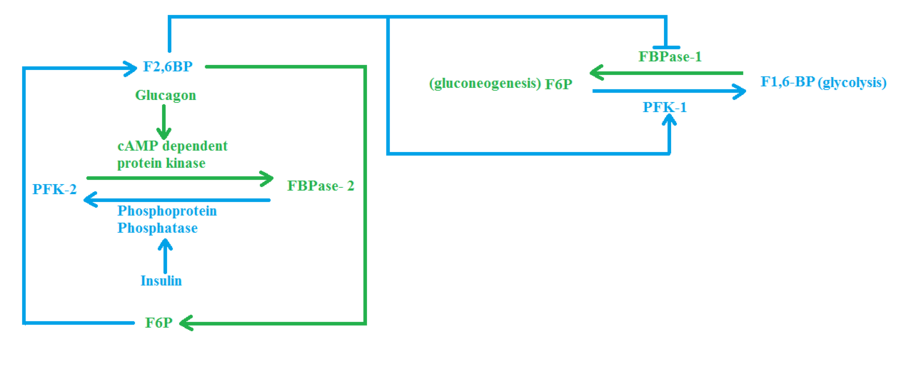Question
In: Chemistry
How does regulation of glycolysis and gluconeogenesis overlap?
How does regulation of glycolysis and gluconeogenesis overlap?
Solutions
Expert Solution
Mostly F16BP is converted to F6P instead of the reverse reaction. Now there is high amount of F6P which compete with glucose to decide where Hexokinase-regulatory protein complex will be located at cytoplasm (to provide phosphorylation of glucose to G6P) or nucleus (to leave glucose its non-phosphorylated form), at liver. Because in this condition F6P "wins" the race, F6P triggers the movement of complex towards nucleus. Thus now new glucose molecules cannot enter glycolytic pathway. By this mechanism, liver lowers its glucose consumption to preserve glucose reservoir.

Related Solutions
Why is it important that the regulation of glycolysis and gluconeogenesis be coordinated?
Why is it important that the regulation of glycolysis and
gluconeogenesis be coordinated?
5.Consider the regulation of glycolysis, gluconeogenesis, pyruvate dehydrogenase, and the TCA cycle, how is the regulation...
5.Consider the regulation of glycolysis,
gluconeogenesis, pyruvate dehydrogenase, and the TCA cycle, how is
the regulation of these pathways linked to thermodynamics? How are
they linked to one another?
Regulation of GNG and glycolysis Describe how high energy charge favors gluconeogenesis over glycolysis based on...
Regulation of GNG and glycolysis
Describe how high energy charge favors gluconeogenesis
over glycolysis based on the ratio of [ATP]/[AMP] of high energy
charge and allosteric regulation (McKee page 298).
Describe how low energy charge measured by low ratio of
[ATP]/[AMP] inhibits the rate of GNG based on allosteric regulation
of fructose 1,6 bisphosphatase by AMP.
Compare the rates of GNG and glycolysis in a liver cell
with low energy charge based on allosteric
regulation.
Differentiate between the blood concentrations...
Describe the role of the bifunctional enzyme in the reciprocal regulation of glycolysis and gluconeogenesis.
Describe the role of the bifunctional enzyme in the reciprocal
regulation of glycolysis and gluconeogenesis.
How does allosteric modulation regulate glycolysis, gluconeogenesis, and glycogen levels?
How does allosteric modulation regulate glycolysis,
gluconeogenesis, and glycogen levels?
What are some differences between the production of glycolysis and gluconeogenesis, and why does gluconeogenesis require...
What are some differences between the production of glycolysis
and gluconeogenesis, and why does gluconeogenesis require a higher
amount of ATP? Utilize examples and explain thoroughly the
differences.
1. Briefly explain the regulation of gluconeogenesis and glycolysis by fructose 2,6-bisphosphate (F-2,6-BP) and how its...
1. Briefly explain the regulation of gluconeogenesis and
glycolysis by fructose 2,6-bisphosphate (F-2,6-BP) and how its
concentration ismediated by insulin and glucagon.
A difference between glycolysis and gluconeogenesis is that gluconeogenesis takes place in the mitochondria gluconeogenesis uses...
A difference between glycolysis and gluconeogenesis is that
gluconeogenesis takes place in the mitochondria
gluconeogenesis uses 14 steps to 10 for glycolysis
gluconeogenesis uses GTP
gluconeogenesis produces more energy than glycolysis
In the muscle, hexokinase will be inhibited by
low levels of ATP
high levels of glucose 6-phosphate
low levels of glucose 6-phosphate
high levels of fructose 6-phosphate
Formation of fructose 6-phosphate requires the aa
Lys
b. Glu
c. Cys
d. Ser
Of dietary glycogen and...
When gluconeogenesis is activated during fasting in liver, glycolysis slows. How does this happen? a. pyruvate...
When gluconeogenesis is activated during fasting in liver,
glycolysis slows. How does this happen?
a. pyruvate kinase and pyruvate dehydrogenase are both inhibited
by phosphorylation in response to a decreased insulin/glucagon
ratio
b. PFK-2 is phosphorylated
c. acetyl CoA allosterically inhibits pyruvate dehydrogenase
d. acetyl CoA allosterically activates pyruvate carboxylase
e. all of the above
Fructose 2,6-bisphosphate has what effects on glycolysis and gluconeogenesis? A. Enhances glycolysis only. B. Enhances gluconeogenesis...
Fructose 2,6-bisphosphate has what effects on glycolysis and
gluconeogenesis?
A.
Enhances glycolysis only.
B.
Enhances gluconeogenesis only/
C.
Inhibits glycolysis only
D.
Inhibits gluconeogenesis only.
E.
Enhances glycolysis/inhibits gluconeogenesis
F.
Inhibits glycolysis/enhances gluconeogenesis
ADVERTISEMENT
ADVERTISEMENT
Latest Questions
- Can you think of any instances in which non-shared, traditional approaches to leadership would be preferable...
- The income statement of Oriole Company for the month of July shows net income of $3,490...
- When flights are delayed, do two of the worst airports experience delays of the same length?...
- 1.Why is important to understand dynamic multi-dimension arrays as “arrays of arrays?” a.Each dimension requires another...
- A crate of mass 9.0 kg is pulled up a rough incline with an initial speed...
- C3H8 + 5O2 ---> 3CO2 + 4H2O How many grams of carbon dioxide are produced from...
- How does theory affect practice in counseling?
ADVERTISEMENT
 queen_honey_blossom answered 3 years ago
queen_honey_blossom answered 3 years ago